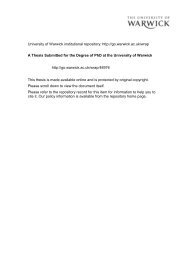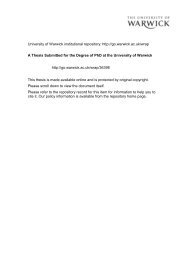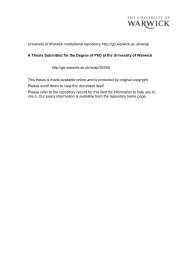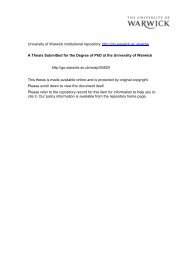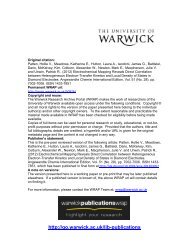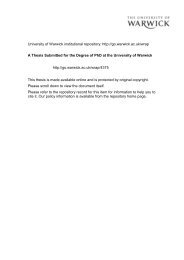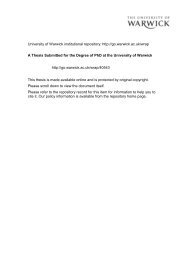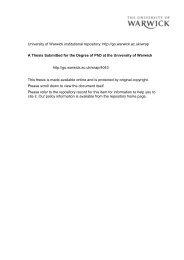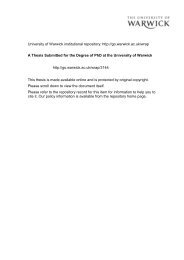Download (13Mb) - WRAP: Warwick Research Archive Portal ...
Download (13Mb) - WRAP: Warwick Research Archive Portal ...
Download (13Mb) - WRAP: Warwick Research Archive Portal ...
You also want an ePaper? Increase the reach of your titles
YUMPU automatically turns print PDFs into web optimized ePapers that Google loves.
consciously many textual boundaries and by re-forming language, re-form notions of<br />
self and reality. Their choice to focus on (inter)textuality is concerned with an<br />
emphasis on their re-interpretation ofthe Real. As De Lauretis writes, drawing on the<br />
work of Jameson, interpretation 'can be seen as a rewriting of the text intended to<br />
show how the text itself is "the rewriting or restructuration of a prior historical or<br />
ideological subtext," which the process ofinterpretation (re)constructs as the symbolic<br />
resolution of determinate contradictions in the Real.,IIBy writing such interpretative<br />
texts these writers unpick that symbolic resolution, returning to the contradictions of<br />
the Real and working with this material rather than against it. The fantastic is used to<br />
shift reader and writer into a new spatial relationship with the text and the real.<br />
The fantastic is a genre that has only begun to gain substantial critical attention<br />
in Italy recently. It is no coincidence that the first instance ofthe recent integration of<br />
the fantastic into the mainstream was a female-authored novel: La casa suI lago della<br />
luna (1984) by Francesca Duranti. 12 Mavina Papini, one of the few so far to attempt<br />
to profile the history of the women's fantastic, draws attention to the string of<br />
twentieth century female voices sidelined because they seemed anomalous, which in<br />
fact form a clear lineage of a female tradition of the fantastic.F It is still the case,<br />
however, that as a result of the perceived lack of tradition of this kind of writing<br />
amongst women, these writers have suffered neglect and demand the justice of<br />
Fofi: Perche Rimbaud con il suo bisogno di uscire dai confini, di ripensare la vita, ha avuto un tipo di<br />
tensione che presenta 10 stesso carattere di visionarieta. II vero dilemma e tra questa bisogno e la<br />
verbilizazzione: un bisogno avvertito oggi piu dalle scrittrici e di conseguenza dalle critiche.' (p.14)<br />
11 Teresa De Lauretis, Technologies of Gender: Essays on Theory, Film and Fiction (London:<br />
Macmillan, 1989), p.8l.<br />
12 Gianfranco De Turris, ' "Made in Italy" II fantastico e l'editoria' in Geograjia, storia e poetiche del<br />
fantastico, ed. by Monica Farnetti (Firenze: Olschki, 1989), pp.217-229, (pp.225-6). He writes of 'una<br />
nuova significativa "rivoluzione" editoriale: la caduta inavvertita rna progressiva degli steccati di<br />
"genere", con la conseguente assunzione di piena "dignita culturale" da parte della letteratura<br />
dell'Irnmaginario e i suoi autori, fino a queI momento esclusi dal circuito delle grandi collane di<br />
narrativa - con qualche nota eccezione: Buzzati, Calvina, un certo Landolfi. A partire dal 1984-5<br />
vennero infatti pubblicati, accanto a opere "realistiche", anche romanzi di autori italiani appartenenti 0<br />
almeno vicino a questa area. II primo fu La casa sui/ago della luna di Francesca Duranti (Rizzoli), poi<br />
fu la volta di Dio e il computer di Roberto Vacca (Bompiani) e di Cercando l'imperatore di Roberto<br />
Pazzi (Marietti), quindi tocco a Concerto rosso di Pier Luigi Berbotto, a Palladion di Valerio Manfredi<br />
e a Partiranno di Luce D'Eramo (tutti editi da Mondadori). Fantastico e fantascienza, mito e<br />
fantastoria, orrore e gotico, allo stato puro made in Italy, facevano irruzione nella grande editoria con<br />
opere di qualita, ben scritte, ed aprivano la strada - e da sottolineare: in collane non specializzate,<br />
quindi indirizzata un pubblico medio - ad altri autori italiani che si avventurano in questi territori, come<br />
oggi accade quasi normalmente. '<br />
13 Mavina Papini, La /etteratura fantastica femminile del Novecento: L 'esperienza di Anna Maria<br />
Ortese (unpublished degree thesis, University of Florence, 1996-1997), p.l. In the introduction she<br />
writes: 'L'analisi qui presentata attinge a un campionario di voci femminili contraddistinte da tratti<br />
evidentemente "fuori dalla norma". Voci apparentemente isolate nella polifonia del discorso letterario,<br />
se colte singolannente, esse si rivelano segni riconoscibili di un ampio e fluido percorso del fantastico<br />
4




